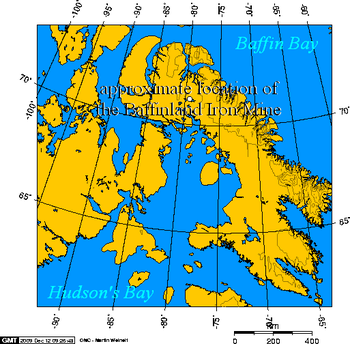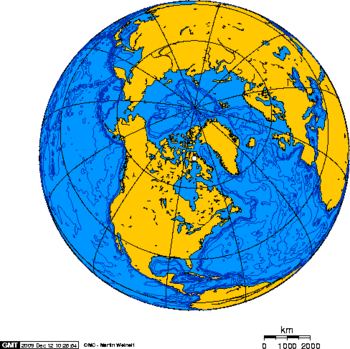Baffinland Iron Mine: Difference between revisions
imported>George Swan (fix refs) |
imported>George Swan (fix refs) |
||
| Line 220: | Line 220: | ||
[http://www.webcitation.org/query?url=http%3A%2F%2Fwww.sikunews.com%2Fskriv_ut.html%3Fcatid%3D5%26artid%3D6135&date=2009-05-03 mirror] | [http://www.webcitation.org/query?url=http%3A%2F%2Fwww.sikunews.com%2Fskriv_ut.html%3Fcatid%3D5%26artid%3D6135&date=2009-05-03 mirror] | ||
</ref> | </ref> | ||
Nunavut Tunngavik controls the resource exploitation of [[ | Nunavut Tunngavik controls the resource exploitation of [[Unuit]] owned lands. | ||
The agreement allows Baffinland exploration and resource development rights to 17,000 hectares of Iniut owned land adjacent to the mine-site. | The agreement allows Baffinland exploration and resource development rights to 17,000 hectares of Iniut owned land adjacent to the mine-site. | ||
==References== | ==References== | ||
<references/> | <references/> | ||
Revision as of 00:16, 18 January 2012
]]
The Baffinland Iron Mines Corporation is working to develop a large open pit iron mine in the Mary River area of Baffin Island, Nunavut, Canada.[1][2][3][4][5][6]
The ore body
Iron ore was first found in the Mary River area in 1962.[4] But exploitation of the ore body waited for an increase in the price of ore. According to the Railway Gazette the ore in this ore-body is sufficiently pure that it will not be necessary to conduct any processing before shipping it to market.
The Corporation expects to sell the ore in Europe at $67 per tonne for lump ore and $55 per tonne for fines.[4] The Corporation expects to prodcue 18 million tonnes per year for 20 years or more, and to pay down the cost of building the mine within the first 3 to 7 years.
In 2008 a 150,000 tonne sample was shipped to Europe for testing.[7][8] The ore was transported to Milne Inlet, where it was carried by barges to a freighter waiting off-shore.
Financing
Australian newspaper The Age reported that due to the financial crisis of 2007 Baffinland needed to secure an emergency loan of 43.8 million Canadian dollars, in order to ship enough supplies for the workers on site -- or they would not have been able to survive the winter.[9] According to The Age the emergency line of credit was necessary because the Baffinland management did not have the funds available to ship supplies to the 200 workers on site before shipping closed for the season, "after investing in commercial paper that borrowers couldn't repay." According to The Age 95 percent of Baffinland's funds had been invested in short term debts investment vehicles, of 364 days or less.
Operation
The mine is planned to commence operations in 2014, staffed by a crew of 500.[4] The sun sets on November 18th and does not rise again until January 23rd. But the Corporation is considering whether some portion of the sunless period will have sufficient hours of twilight to continue operations.
Railway
The Corporation plans to construct a railroad line to transport the ore to a port for transhipment.[4] Two routes were considered.[3] Initially a 100 kilometre route to Milne Inlet on Baffin Island's North Shore was preferred. However a 149 kilometre route to Steensby Inlet on the South Shore was chosen because it is ice-free for a longer portion of the year.
According to the Financial Post this will be the most northerly railroad in the world.[10]
Railbed
Construction of the rail line is planned to begin in 2010.[4] Because Baffin Island's soil is permafrost, the route was chosen so it lies on rock, gravel, or large-grained sand as much as possible. Fine-grained sand and clay soils pose more of a heaving problem when the surface layer annually thaws and freezes. The route will five multi-span bridges totalling 1400 metres in length. Two tunnels 800 meters and 250 meters will be required. The tunnels will have to be lined and insulated to make sure waste heat from the trains doesn't melt the permafrost surrounding the tunnel. The route detours around large areas of poorly drained glacial deposits and areas likely to contain deposits of fossil ice.
It is planned to use older carbon steel alloys for the rails, instead of more modern, higher performance alloys, because they can become brittle at very low temperatures.[4] The rails and bridges are designed for fifty years of active service.
Rolling stock
The corporation plans to purchase three train sets, each containing 64 hopper cars, which will each make two round trips per day.[4] The Railway Gazette reported in July 2008 that EMD SD70 and GE Dash-9 were candidates for the lines' locomotives. A personnel train would run several times per week.
Nine icebreaking freighters
According to the CBC Baffinland plans to employ nine icebreaking freighters, each displacing 190,000 tonnes.[11] Baffinland plans to contract Fednav to manage its shipping. When in full operation Baffinland plans to fill one freighter every two days. The plan to have freighters operating year-round has stirred controversy, because of its potential impact sea mammals living on the winter ice-pack.
Environmental concerns
The Canadian Broadcasting Corporation interviewed First Nations people from the region in April 2008, about their concerns with the plans.[12] Jaypetee Palluq, an Igloolik resident who had been asked to serve on a Baffinland advisory committee, was concerned that the mine's operation would interfere with the traditional hunts for sea mammals, like Walrus. He called on Baffinland to "find an alternate shipping route to the mine, regardless of the cost." Paul Quassa, Mayor of Igloolik, also expressed concern, over the effect of freighters on the ice used by the Walrus. He said the region was known for its highly prized aged, fermented walrus meat, a valuable export from the region.
In August 2008 the CBC reported that Baffinland acknowledged three fuel spills.[13] Baffinland's vice-president of sustainable development, Derek Chubb, asserted that the three spills were contained within "secondary engineered containment facilities", and that there was no environmental damage. 5,000 litres of aviation fuel leaked from a fuel bladder at the mine's port facilities on Milne Inlet. The other two leaks of 200 litres, occurred near the mine site. Baffinland acknowledged that the leaks had been found months earlier, but had not been made public. Michael Nadler, the regional director general of the Department of Indian and Northern Affairs speculated that mine officials may not have felt an obligation to publicly report the leaks because they believed there had been no damage.
On September 22 2008 100,000 litres of contaminated water was released in what officials described as "human error".[14][15]
Future expansion
The Corporation has signed a joint venture agreement with Nunavut Tunngavik Incorporated.[16][17] Nunavut Tunngavik controls the resource exploitation of Unuit owned lands. The agreement allows Baffinland exploration and resource development rights to 17,000 hectares of Iniut owned land adjacent to the mine-site.
References
- ↑ Arctic iron ore line proposed, Railway Gazette, 2006-07-01. Retrieved on 2009-05-01. mirror
- ↑ Baffinland Announces New Members of the Baffinland Team to Advance its World Class Iron Ore Project, Mining Top News, 2007-04-10. mirror
- ↑ 3.0 3.1 Baffin Island arctic ore line advances, Railway Gazette, 2008-04-25. Retrieved on 2008-08-10. mirror
- ↑ 4.0 4.1 4.2 4.3 4.4 4.5 4.6 4.7 Carolyn Fitzpatrick. Heavy haul in the high north, Railway Gazette, 2008-07-24. Retrieved on 2008-08-10. mirror
- ↑ Baffin Island Iron, Arctic Economics, 2008-07-28. mirror
- ↑ David K. Joy. Mary River Iron Project. mirror
- ↑ Julie Gedeon. ARCTIC SHIPPING SPECIAL REPORT: Floating wharf gets around lack of Arctic infrastructure, Canadian Sailings, 2009-03-02. mirror
- ↑ Sample ore from Nunavut iron project en route to Netherlands, CBC News, 2008-09-08. Retrieved on 2009-12-12.
- ↑ Rob Delaney. Credit freeze takes its toll in Canada, The Age, 2007-09-26. mirror
- ↑ Julie Gordon. Baffinland: Developing Arctic iron ore mine is no easy task, Financial Post, 2011-01-18. Retrieved on 2012-01-17. mirror
- ↑ Marine shipping route tops Igloolik concerns about mine proposal: mayor, CBC News, 2009-04-19. Retrieved on 2009-12-12.
- ↑ Baffin Island residents resist proposed iron mine plans, CBC News, 2008-04-08. Retrieved on 2009-12-12.
- ↑ Baffinland reports 3 fuel spills at Nunavut site, CBC News, 2008-08-18. Retrieved on 2009-12-12.
- ↑ Human error led to spill at Mary River mining site: Baffinland, CBC News, 2008-10-03. Retrieved on 2009-12-12.
- ↑ Federal investigators to look into Baffinland oil, grease spill, CBC News, 2008-10-14. Retrieved on 2009-12-12.
- ↑ Baffinland Forms Exploration Joint Venture With Nunavut Tunngavik Inc., Mining Top News, 2008-09-10. mirror
- ↑ Iron mine- Inuit strike an MOU, Siku News, 2009-04-01. mirror

